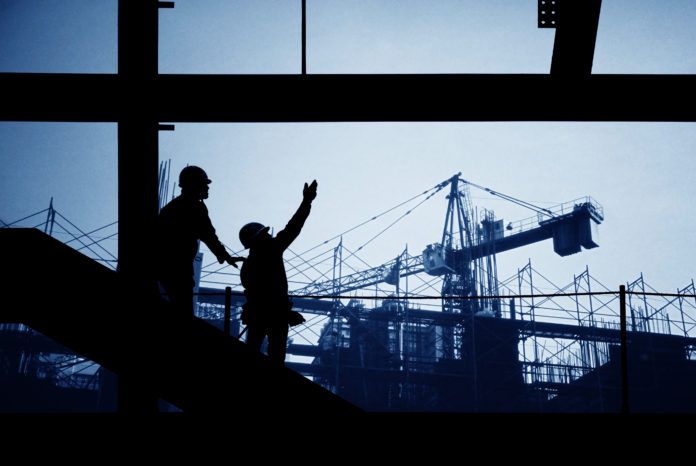The latest IHS Markit/CIPS PMI data has signalled another sharp increase in UK construction activity at the end of the third quarter.
The expansion came amid the sharpest rise in new business since before the pandemic-induced lockdown, with firms increasing their purchasing activity at the quickest pace for nearly five years.
Meanwhile, employment continued to fall, but the rate of job shedding eased. Looking forward, sentiment towards future activity was the strongest for seven months.
The headline seasonally adjusted IHS Markit/CIPS UK Construction Total Activity Index registered 56.8 in September, up from 54.6 in August. Any figure above 50.0 indicates growth of total construction output.
The latest reading pointed to a reacceleration in the rate of activity growth and a sharp increase overall. Underlying data revealed varied results across the three monitored sub-sectors. The strongest performing category was homebuilding, where firms registered a sharp expansion in activity for the fourth month running.
Work undertaken on commercial projects also rose strongly, increasing at the quickest pace for over two years. Meanwhile, civil engineering activity fell for the second month running, and at the sharpest rate since May.
Anecdotal evidence suggested that the expansion in overall activity was predominantly driven by an improvement in demand conditions during September. New orders rose for the fourth time in as many months, with panellists continuing to mention a release of pent-up demand.
In fact, the latest increase was the strongest since just before the escalation of the coronavirus pandemic.
In line with the rise in new work, UK construction firms recorded another marked increase in purchasing activity at the end of the third quarter. Moreover, the rate of growth accelerated to the fastest since October 2015. On the employment front, staff numbers continued to fall in September. However, the rate of workforce contraction eased to the slowest for seven months.
When explaining job cuts, some panellists mentioned releasing furloughed workers, following a restructuring of their operations. Meanwhile, cost burdens faced by building companies continued to rise. That said, the rate of inflation eased for the first time in six months to the weakest since May.
Panellists often noted higher raw material prices amid shortages at suppliers, with data indicating another sharp deterioration in vendor performance.
Finally, confidence towards the 12-month business outlook was the strongest since February. Optimism was supported by expectations of a sustained rise in new work.
Industry reaction to the IHS Market/CIPS PMI data
Eliot Kerr, an economist at IHS Markit, which compiles the survey, said: “Following August’s slowdown, growth in UK construction activity rebounded strongly in September. There were faster increases in activity in both the housing and commercial sub-sectors, which more than offset a sharper decline in civil engineering work.
“Forward-looking indicators point to a sustained rise in activity, with new work increasing at the quickest pace since before the lockdown, and sentiment towards the 12-month outlook at its strongest for seven months.
“Meanwhile, the latest PMI data pointed to another fall in employment numbers across the UK construction sector. That said, the rate of job shedding eased substantially, while building firms upped their purchasing activity in a further sign of encouragement for the months ahead.”
Duncan Brock, group director at the Chartered Institute of Procurement & Supply, added: “UK construction took off in September, soaring ahead of both the manufacturing and service sectors in terms of output growth, and recording the fastest rise in purchasing activity since October 2015. Fuelled by the easing of lockdown measures, new orders rose for the fourth month in a row, and at the quickest pace since the beginning of the year before the pandemic struck.
“Of the three monitored subsectors, housebuilding was the strongest performer, with activity increasing for the second month in a row, partially driven by residential-related services such as home improvements. However, civil engineering took another backwards step, and progress worsened significantly as bigger construction developments stayed in suspended animation. Government support schemes are winding down, so the bigger worry remains the level of job creation.
“With another drop in employment numbers, vacancies were sparse and further redundancy schemes could be on the cards once this pent-up demand for work is satisfied. But for now, builders are stocking up for Brexit and COVID preparations, so purchasing remains strong in spite of longer delivery times and some shortages. Optimism is at a seven-month high, so builders are enjoying this resurgence in activity, following the summer lows.”
Meanwhile, the sharp increase in UK construction activity in September, offers hope for new jobs in the building industry, says the Federation of Master Builders (FMB).
Brian Berry, chief executive of the FMB, said: “Growing activity in the construction industry should make this an attractive sector for young people considering their next steps after school, and people leaving other industries looking to retrain.
“Construction has a key role to play in rebuilding the economy as recognised by the Prime Minister in his ‘build, build, build’ speech earlier this year. However, to ensure high standards, the industry needs to ‘train, train, train’. This means the trades need to be prioritised in the government’s funding allocations for colleges. It also means we need to strengthen colleges’ links with employers so that we join the dots.”




